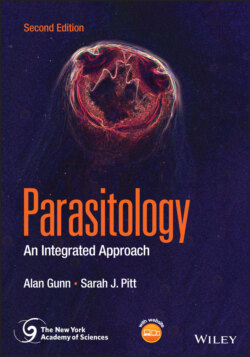Читать книгу Parasitology - Alan Gunn - Страница 107
4.2.1.2 Visceral Leishmaniasis
ОглавлениеClassical visceral leishmaniasis is commonly known as kala‐azar and causes fevers like those of malaria. Both malaria and kala‐azar occur in the same areas, so it is important for doctors to distinguish between them. The name kala‐azar (black head) derives from the symptomatic darkening of the forehead and mouth of patients suffering from visceral leishmaniasis. In India, great plagues of visceral leishmaniasis occurred in Assam in the late nineteenth and early twentieth centuries that depopulated whole villages. Serious outbreaks still occur today, and visceral leishmaniasis remains an important cause of morbidity and mortality in over 70 countries around the world. Most cases of visceral leishmaniasis occur in South Asia (~67%), but it is also a big problem in parts of East Africa (e.g., Sudan in the region bordering with Ethiopia). There is also a focus of infection in South America, especially in Brazil.
The clinical picture of visceral leishmaniasis differs geographically. There is, nonetheless, a basic pattern to the course of the disease. The first stage begins when a papule develops at the site of the sandfly bite, but this eventually regresses. Low‐grade recurrent fevers then develop anything from 10 days to 2 years or more afterwards, and these persist throughout the course of the disease. Within the spleen, immune‐related responses destroy red blood cells, and this causes anaemia. In addition, the liver becomes enlarged (hepatomegaly) as does the spleen (splenomegaly). Enlargement of the spleen results from a combination of hyperplasia induced by the need to produce new mononuclear phagocytes and from infected mononuclear phagocytes filling with parasites. The patient often suffers from diarrhoea and this, together with the fever, leads to anorexia, malnutrition, and dehydration. If the disease is not treated, 90% of those suffering visceral leishmaniasis will die. Recovery can be rapid and complete with or without treatment. However, in many cases the parasite persists and may appear on the skin in raised macules causing the disfiguring condition post kala‐azar dermal leishmaniasis.
